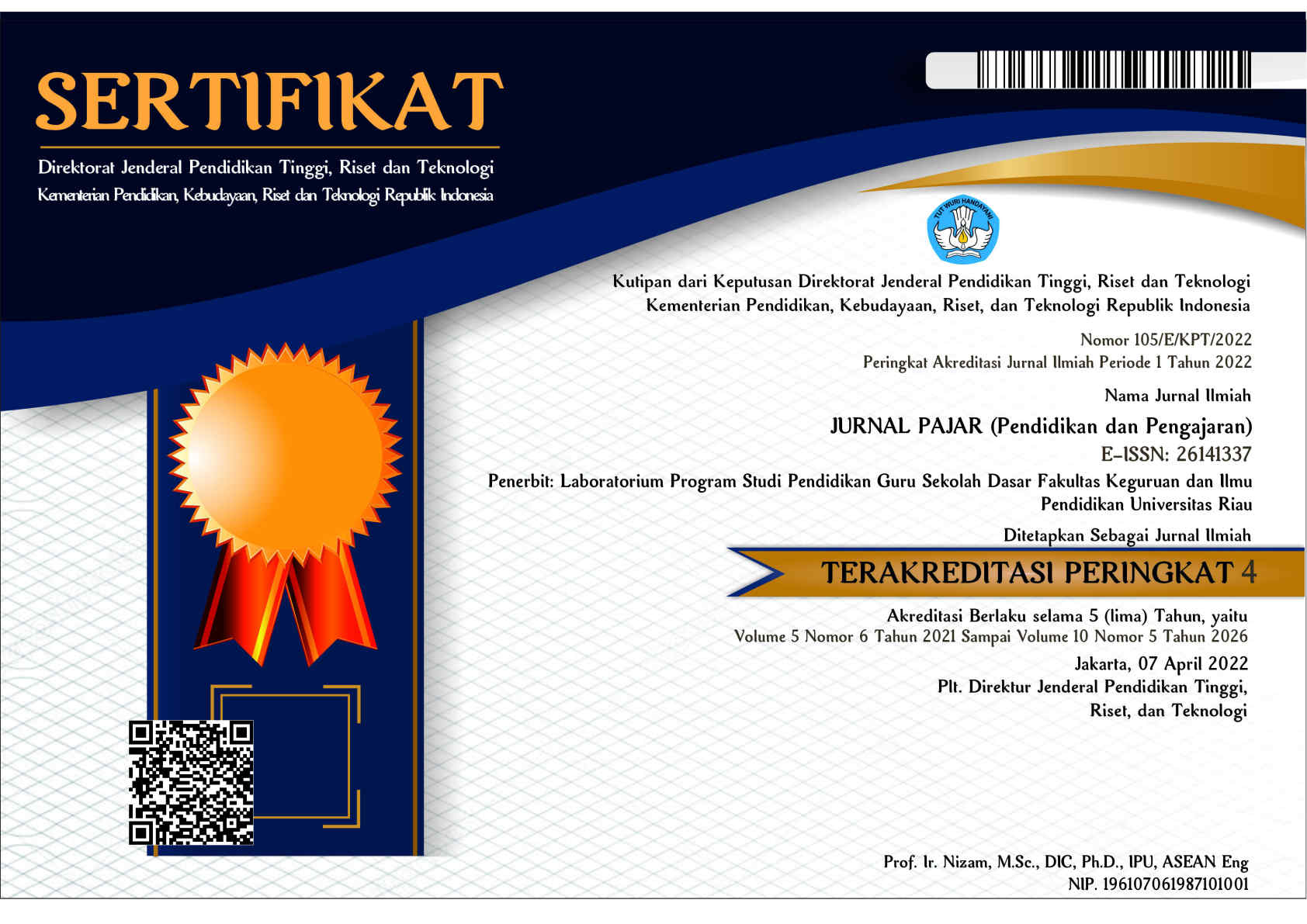IMPLEMENTING DIRECTED READING ACTIVITY (DRA) STRATEGY IN IMPROVING READING COMPREHENSION ABILITY
Abstract
The purpose of this study was to improve students' reading comprehension ability through DRA strategy. This study was conducted by using classroom action research at grade I involving 28 students. The results of this study revealed that during the observation in Cycle I meeting I, teachers’ activities was in low category with a score of 10 or 50.00%. Then, the score increased to 12 or 60.00% in meeting II Cycle I with sufficient category. Moreover, in Cycle II meeting I, the score of teacher's activity increased to 15 or 75.00% with good category, and in meeting II, again it increased 17 or 85.00% with very good category. In addition, this study also found that the students’ reading comprehension ability before implementing DRA strategy was 39.29 with incomplete category. After implementing DRA strategy, the average score of classical completeness increased to 50 with incomplete category. After conducting the reflection on learning in cycle I, the results of students’ completeness reached 79 with complete category even though it was not in accordance with the high target of improvement.
Keywords
Full Text:
PDF (BAHASA INDONESIA)References
Arikunto, S. (2008). Penelitian Tindakan Kelas. Bandung: Remaja Rosda Karya.
Astiningtyas, A. (2018). Kesiapan Guru Sekolah Dasar Dalam Pelaksanaan Pembelajaran Tematik Integratif Pada Kurikulum 2013. Primary: Jurnal Pendidikan Guru Sekolah Dasar, 7(1), 60-67.
Epstein, L. R., & Kernberger, C. (2006). The Pocket Guide To Critical Thinking. Thomson/Wadsworth.
Noviana, E., Kurniaman, O., & Huda, M. N. (2018). Pengembangan Aplikasi Bimbingan Tugas Akhir Mahasiswa Berbasis Website Pada Program Studi Pendidikan Guru Sekolah Dasar Fkip Universitas Riau. Primary: Jurnal Pendidikan Guru Sekolah Dasar, 7(1), 1-12.
Fadhillah, A. M. (2017). Embedding Critical Thinking Through Critical Reading: Teaching Narrative Text In Junior High School. Journal of English and Education, 5 (2), pp. 92 – 102. URL: http://ejournal.upi.edu/index.php/L-E/article/view/9938.
Kurniaman, O., Oktari, C., & Pahrurazi, P. (2019). The Implementation of Teaching Materials Reading Graphic Organizers in Elementary Schools. Lensa: Kajian Kebahasaan, Kesusastraan, dan Budaya, 9 (2), 105-119. DOI: https://doi.org/10.26714/lensa.9.2.2019.105-119.
Kurniaman, O., Noviana, E., Charlina, C., S. B. Simulyasih, N., Handayani, N. D., Sofyan, N. S., Zufriady, Z., Septyanti, E. (2018). Why Should Primary Teachers Develop Learning Material by Directed Reading Thinking Activity (DRTA) Strategy?: 4-D Model. Advanced Science Letters, 24(11), 8389–8391.
Kurniaman, O., Hidayat, M. L., Noviana, E., Munjiatun, M., & Kurniawan, K. (2020). The Validation of LIAA (Linguistic Intelligence Assessment Android) Development In Elementary School. PPD Profesi Pendidikan Dasar, 7(2), 162-170. DOI: 10.24036/blbs.v17i1.12696.
Miri, B., David, B., & Uri, Z. (2007). Purposely Teaching for the Promotion of Higher-order Thinking Skills: A Case of Critical Thinking. Research in Science Education, 353-369 .
Rahim, F. (2005). Pengajaran Membaca di Sekolah Dasar. Jakarta: Bumi Aksara.
Saidah, H. (2017). Pengaruh Program Gemar Membaca terhadap Kemampuan Mengarang Siswa Kelas IV SD. Mimbar Sekolah Dasar, 4(3), 225–234. http://doi.org/10.17509/mimbar-sd.v4i3.7863.
Taglieber, L. K. (2008). Critical Reading and Critical Thinking. Ilha do Desterro A Journal of English Language, Literatures in English and Cultural Studies.
Yamashita, J., & Shiotsu, T. (2015). Comprehension and Knowledge Components That Predict L2 Reading: A Latent-Trait Approach. Applied Linguistics, 2. 1-26. doi:10.1093/applin/amu079.
Zuchdi, D., dan Budiasih. (2001). Pendidikan Bahasa dan Sastra Indonesia di Kelas Rendah. Yogyakarta: PAS.
DOI: http://dx.doi.org/10.33578/pjr.v5i3.8404
Refbacks
- There are currently no refbacks.
Copyright (c) 2021 JURNAL PAJAR (Pendidikan dan Pengajaran)

This work is licensed under a Creative Commons Attribution-NonCommercial-ShareAlike 4.0 International License.
JURNAL PAJAR (Pendidikan dan Pengajaran)
Secretariat
Program Studi Pendidikan Guru Sekolah Dasar
Gedung B1, FKIP Universitas Riau
Kampus Bina Widya Km. 12,5 Simpang Baru Panam
Pekanbaru Riau Indonesia 28293
e-mail : pajar@ejournal.unri.ac.id



